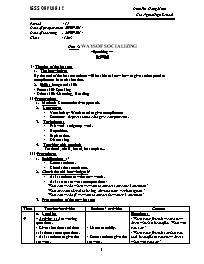Giáo án Tiếng Anh Lớp 12 - Unit 3: Ways of socializing - Period 15: Speaking - Năm học 2014-2015 - Đinh Thị Hồng Minh

I/ The aim of the lesson:
1. The knowledge:
By the end of the lesson students will be able to know how to give and respond to compliments in each situation.
2. Skills: Integrated skills
- Focus skill: Speaking
- Other skills: Listening, Reading.
II/ Preparation:
1. Method: Communicative approach.
2. Language:
- Vocabulary: Words used to give compliments
- Structure: Expression used to give compliments.
3. Techniques:
- Pair work and group work.
- Repetition.
- Explanation.
- Discussing.
4. Teaching aids needed:
Textbook, chalk, board, lesson plan.
III/ Procedure:
1. Stabilization: 1’
- Greets students.
- Checks the attendance.
2. Check the old knowledge: 6’
- Asks students to write new words.
- Asks sts to answer some questions:
+ What can we do when we want to attract someone’s attention?
+ What are considered to be big, obvious non- verbal signals?
+ What can we do if we want to attract the waiter’s attention?
Period : 15 Date of preparation: 20/09/2014 Date of teaching : 26/09/2014 Class : 12A3 Unit 3: WAYS OF SOCIALIZING --Speaking— Ñ&Ð I/ The aim of the lesson: The knowledge: By the end of the lesson students will be able to know how to give and respond to compliments in each situation. Skills: Integrated skills - Focus skill: Speaking - Other skills: Listening, Reading. II/ Preparation: Method: Communicative approach. Language: Vocabulary: Words used to give compliments Structure: Expression used to give compliments. Techniques: Pair work and group work. Repetition. Explanation. Discussing. Teaching aids needed: Textbook, chalk, board, lesson plan... III/ Procedure: Stabilization: 1’ Greets students. Checks the attendance. Check the old knowledge: 6’ Asks students to write new words. Asks sts to answer some questions: + What can we do when we want to attract someone’s attention? + What are considered to be big, obvious non- verbal signals? + What can we do if we want to attract the waiter’s attention? Presentation of the new lesson: Time Teacher’s activities Students’ activities Content 4’ 6’ 6’ 9’ 9’ Lead in: * Activity 1: Answering questions. - Gives situations and then asks them some questions. - Asks students to give the answers. - Gives feedbacks. - Leads to the new lesson. Pre-speaking: * Activity 2: Teaching new words: - Introduces some new words. - Reads aloud these new words then asks students to repeat. - Asks some students to read aloud these new words again. * Activity 3: Task 1 - Asks students to find out expression to give and respond to compliments in each situation. - Asks some students to give answers. - Gives feedbacks. - Asks them to practice the dialogues. c. While speaking: * Activity 4: Task 2 - Asks students to do the task in pairs. - Asks some pairs to give answers. - Gives feedbacks. * Activity 5: Task 3 - Asks students to do the task. - Asks some students to present. - Gives feedbacks. - Listen carefully. - Some students give the answers. - Listen to the teacher. - Listen to the teacher. - Listen to the teacher to guess the meaning of these words and take notes on their notebooks - Listen and repeat. - Some students read aloud these new words. - Find out expression. - Some students give answers. - Listen to the teacher. - Practice. - Discuss with their partners to do the task. - Some student present. - Listen carefully. - Do the task. - Some students present. - Listen to the teacher. Situations: - When your friends wear a new dress which is beautiful. What will you say? - When your friends say that you look beautiful in your new dress, what will you say? New words: - compliment (n) -> explain - terrific (adj) - decent (adj) -> explain - terrible (a) = horrible (a) Expression: - You really have a beautiful - I’ve never seen such a perfect thing on you. - Your is terrific. - I thought your was a lot better today. - Thank you! That’s a nice compliment. - You’ve got to be kidding! Suggested answers: - The dress looks nice on you! - I love your motorbike. Did you buy it here? - I didn’t know you could play badminton so well. Suggested answers; - You’re too kind! - Thanks. That’s nice of you to say so. - You’ve got to be kidding! Consolidation: 4’ Asks students to recall some expression to express point of view. Homework: - Talk about students’ family. - Prepare for the new lesson. 6. Experience after the lesson: - Content: - Method: - Time: - Students:
Tài liệu đính kèm:
 giao_an_tieng_anh_lop_12_unit_3_ways_of_socializing_period_1.doc
giao_an_tieng_anh_lop_12_unit_3_ways_of_socializing_period_1.doc





